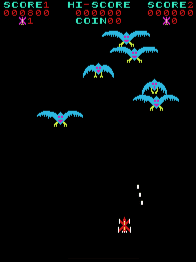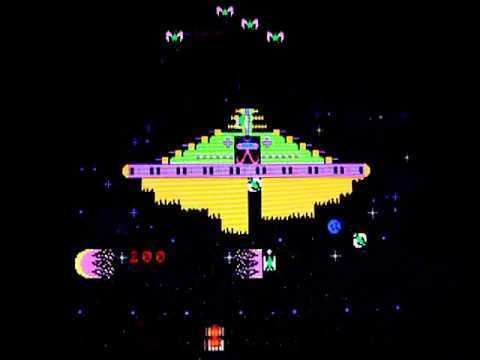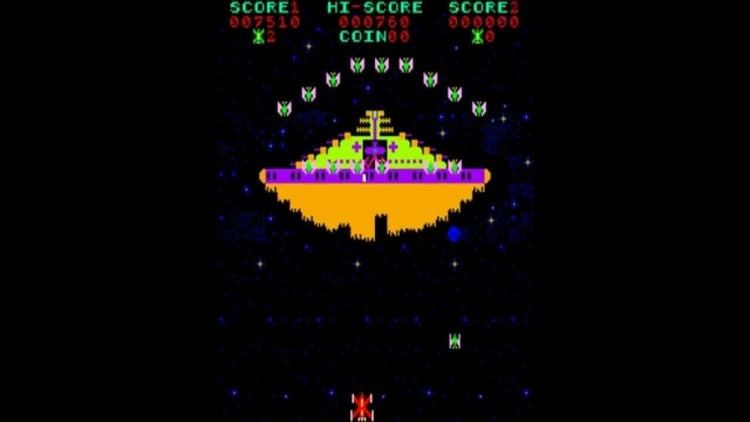Cabinet Upright, cocktail Genre Shoot 'em up | Initial release date 1980 | |
 | ||
Mode(s) 1-2 players alternating Display Vertical raster, standard resolution Similar Atari games, Shoot 'em up games | ||
Phoenix is an outer space-themed, fixed shooter video game similar to Taito's Space Invaders and released in 1980. The game's developer is unknown. According to Centuri's Joel Hochberg, the game was licensed from "a smaller Japanese developer." Amstar Electronics (which was located in Phoenix, Arizona) licensed the game to Centuri for manufacture in the United States. Taito released the game in Japan.
Contents

The Phoenix mothership is one of the first video arcade game bosses to be presented as a separate challenge. This was before the term boss was coined.

Gameplay

The player controls a spaceship that moves horizontally at the bottom of the screen, firing upward. Enemies, typically one of two types of birds, appear on the screen above the player's ship, shooting at it and periodically diving towards it in an attempt to crash into it. The ship is equipped with a shield that can be used to zap any of the alien creatures that attempt to crash into the spaceship. The player cannot move while the shield is active and must wait approximately five seconds before using it again.
The player starts with three or six lives, depending on the settings.
Each level has five separate rounds. The player must complete a round to advance to the next.

The game continues with increasing speed and unpredictability of the bird and phoenix flights.
Hardware
Phoenix was available in both arcade and cocktail cabinets. A DIP switch setting allows the game to be moved between formats.
Most Phoenix games are in a standard Centuri woodgrain cabinet, but several other cabinets exist, due to this game being sold by multiple companies at the same time. These use sticker sideart (which covers the upper half of the machine), and glass marquees. The control panel is made up entirely of buttons; no joystick is present in the Centuri version, except for the international models and some cocktail versions. The monitor in this machine is mounted vertically, and the monitor bezel is relatively unadorned. Phoenix uses a unique wiring harness, which isn't known to be compatible with any other games.
Circuitry in the Centuri version:
Music
There are two pieces of music featured in the game:
Bugs
When the player shoots 3 birds in a row very quickly as they fly upwards a score about 204,000 points is awarded.
It's also known that the player's force field works unreliable. The ship might explode when coming in contact with an enemy or a shot fired although the shield was activated.
Reception and legacy
Bill Kunkel and Arnie Katz of Electronic Games called Phoenix "perhaps the finest invasion title ever produced for the 2600!", praising its "fantastic graphics, unexcelled play-action and more". The game received a Certificate of Merit in the category of "1984 Best Science Fiction/ Fantasy Videogame" at the 5th annual Arkie Awards. AllGame gave Phoenix a five-star rating, their highest rating. The review stated that itwas the "most impressive games the "slide-and-shoot" genre has to offer" and that "Finely balanced shooting action combined with colorfully animated graphics make Phoenix a true classic."
Records
Richie Knucklez holds the official record for this game with 1,007,115 points recorded on the 9 March 2011.
Ports
Atari bought the home video game console rights to Phoenix, which it released for the Atari 2600 in 1982. The Imagic game Demon Attack closely resembled Phoenix, so Atari sued Imagic, who settled out of court.
In 2005, Phoenix was released on the Xbox, PlayStation 2, PSP and the PC as part of Taito Legends in the US and Europe, and Taito Memories II Gekan in Japan.
Sequels
The sister game to Phoenix was called Pleiads (onscreen) or Pleiades (on the Centuri manufactured marquee) and was developed by Tehkan in 1981, and licensed to Centuri for U.S. distribution. Pleiades featured more enemies attacking at once, balanced by the fact that the player could now have two shots on the screen at one time instead of one—coincidentally, something that Galaxian's sequel, Galaga, also introduced.
The Flagship level in the Midway game Gorf has been compared to the boss stage in Phoenix.
